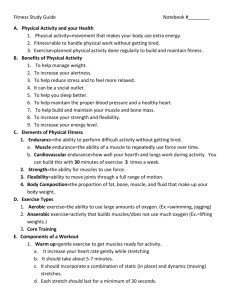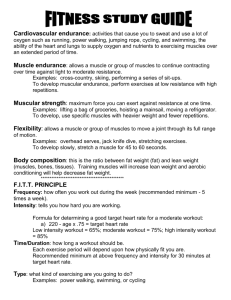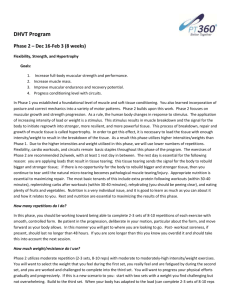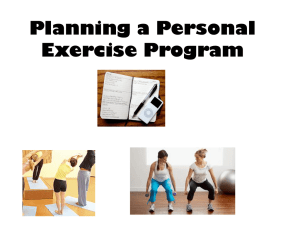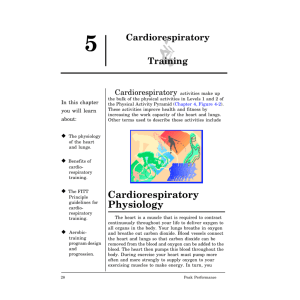Muscular Fitness Study Guide
advertisement
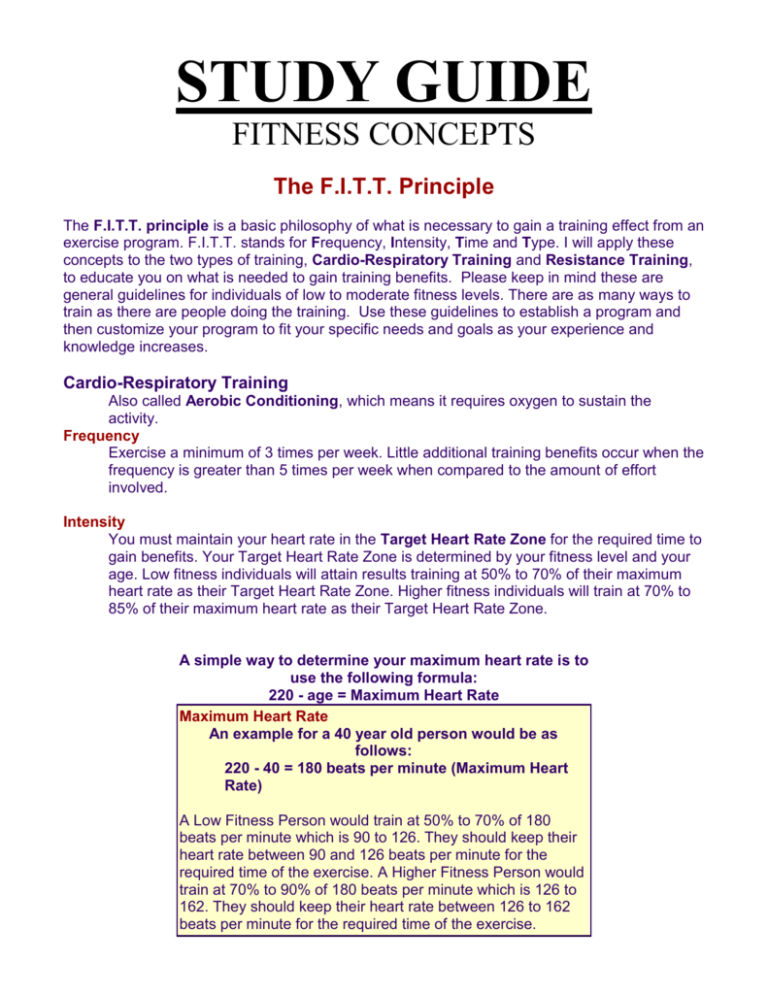
STUDY GUIDE FITNESS CONCEPTS The F.I.T.T. Principle The F.I.T.T. principle is a basic philosophy of what is necessary to gain a training effect from an exercise program. F.I.T.T. stands for Frequency, Intensity, Time and Type. I will apply these concepts to the two types of training, Cardio-Respiratory Training and Resistance Training, to educate you on what is needed to gain training benefits. Please keep in mind these are general guidelines for individuals of low to moderate fitness levels. There are as many ways to train as there are people doing the training. Use these guidelines to establish a program and then customize your program to fit your specific needs and goals as your experience and knowledge increases. Cardio-Respiratory Training Also called Aerobic Conditioning, which means it requires oxygen to sustain the activity. Frequency Exercise a minimum of 3 times per week. Little additional training benefits occur when the frequency is greater than 5 times per week when compared to the amount of effort involved. Intensity You must maintain your heart rate in the Target Heart Rate Zone for the required time to gain benefits. Your Target Heart Rate Zone is determined by your fitness level and your age. Low fitness individuals will attain results training at 50% to 70% of their maximum heart rate as their Target Heart Rate Zone. Higher fitness individuals will train at 70% to 85% of their maximum heart rate as their Target Heart Rate Zone. A simple way to determine your maximum heart rate is to use the following formula: 220 - age = Maximum Heart Rate Maximum Heart Rate An example for a 40 year old person would be as follows: 220 - 40 = 180 beats per minute (Maximum Heart Rate) A Low Fitness Person would train at 50% to 70% of 180 beats per minute which is 90 to 126. They should keep their heart rate between 90 and 126 beats per minute for the required time of the exercise. A Higher Fitness Person would train at 70% to 90% of 180 beats per minute which is 126 to 162. They should keep their heart rate between 126 to 162 beats per minute for the required time of the exercise. To monitor your heart rate you can take your pulse with your first two fingers at various locations: With palm up, find your pulse at your wrist on the thumb side about 1 inch below the joint. With palm up at the elbow find your pulse to the inside of the biceps tendon at the joint. At the side of the neck below the ear, next to the windpipe is a main artery to the head. Knowing your heart rate is important for three reasons: 1. It assures you are training at the right intensity to gain benefit from the exercise. 2. It also assures you are exercising at a safe intensity. 3. It can tell you the amount of time you exercised in your target heart rate zone. Monitoring your heart rate while exercising is especially important if you are at a low fitness level and/or have many risk factors for cardiovascular disease. Finding your pulse can be very inconvenient while performing an exercise. It is difficult trying to locate your heart beat and accurately count the beats per minute while you are exercising, also you may not have a time clock in front of you. You would also have to re-take your heart rate every time you changed the intensity of the exercise to make sure you are still in the safe training zone. This would apply when doing interval training and programs that vary the intensity level. Heart Rate Monitor. These devices are easy to use and comfortable to wear. They allow you to program your Target Heart Rate Zone and you are then alerted when you are training at too high or too low of an intensity. Heart rate monitors also have various features such as monitoring the time you are in the safe and effective training zone. These devices allow you to concentrate on your exercise while you have a safe and effective workout. Time It is necessary to maintain your proper intensity (target heart rate zone) for a duration that will create a training benefit. Low Fitness individuals should maintain their heart rates in their target zone for a minimum of 12 to 15 minutes. This does not include warm-up or cool down periods. As your fitness level increases the exercise time in your target heart rate zone can be extended to 20 - 60 minutes of continuous aerobic activity. Unless you are a competitive athlete, training beyond 60 minutes in your target heart rate zone provides little additional training benefits for the amount of effort exerted. If you are overweight however, long training sessions at a low intensity (50% to 60% of maximum heart rate) utilize fat as an energy source and are helpful in a weight/fat reduction program. Type Choose an exercise that will involve as much muscle mass as possible. In other words, exercises that use the whole body or the larger muscle groups such as the legs and/or the back. Make sure the exercise is of a dynamic contracting nature that involves movement.(not isometric.) The exercise should be rhythmic to allow a consistent intensity. The exercise should be capable of creating the proper training intensity. Some examples of activities that create a constant heart rate response include: Walking, Running, Cycling, Swimming, Rowing, Hiking, Cross Country Skiing Some examples of activities that produce varying intensity (intermittent training) include: Handball, Racquetball, Volleyball, Tennis, Soccer, Squash, Circuit Weight Training Resistance Training Also called anaerobic training which is a term to indicate oxygen isn't required. This is a simple explanation of a more complex metabolic system. In actuality oxygen does play a part in resistance training muscle metabolism through a process called oxygen debt. What happens during anaerobic training is the body uses glycogen storage in the muscle for immediate fuel during heavy exertion. Oxygen is required to replace this fuel and therefore you are in oxygen debt until the exercise is finished and the energy storage is replenished through the process of respiration. Frequency The frequency of training each body part varies with the amount of work done at each exercise session. If you want to do more work at each session then you would exercise less frequently as you will need more time to recuperate. If you do less work per body part at each session then you can train more frequently. A factor in how often you will train depends on your ability to recuperate after your workout and be ready for the next workout. This will be something you will determine on a personal basis. It is better to be consistent in your workouts and make steady progress than to over-train and be discouraged from inconsistent and poor training results. A general guideline would be to do each body part 1 to 2 times per week or every 4-5 days if you are a beginner or are doing high load workouts. For lower intensity workouts or higher trained individuals you could try doing each body part 2 to 3 times per week. You can do different areas of the body on different days or you can train your whole body at each workout only doing a few exercises for each body part. Intensity Intensity is more complicated to measure in resistance training than in Cardio-respiratory training. The main aspect of intensity is workload. The amount of work you do during a workout is your workload. Your workload can be measured by three components. One component is the amount of weight you lift during an exercise. Another component is the amount of repetitions and sets you performed of that exercise. A repetition is one complete movement of an exercise and a set is the number of repetitions an exercise is performed before stopping. The third component is the length of time it took you to complete the training session. Therefore we can summarize by saying the workload or intensity of the training session can be measured by how much weight was lifted, the number of repetitions that was completed, the number of sets of the exercises that were performed and the amount of time it took to complete the workout. You can also determine your workload for just one exercise as well as an entire workout. So it is plain to see that any combination of lower weights, less sets and repetitions and more time will decrease your intensity and by increasing weight, sets, repetitions and less workout time will increase intensity. Choose a weight that can be performed 8-12 times (repetitions), or if you are a true beginner perform 10-15 repetitions before momentary muscle exhaustion prevents you from doing another repetition. This is called training to failure and is important because as you are doing your repetitions your muscle will start to fatigue and the last few repetitions will be at maximum effort or close to maximum contractions. These last few repetitions are what will create a training effect and make changes in the muscle in the shortest period of time. When you get to a point where you perform more than 12 repetitions then you add weight the next time you do the exercise. If you do less than 8 repetitions on your exercise then you do less weight next time and work your way back up to 12 repetitions before you add more weight. It's that simple! If you are training your whole body in one exercise session, then choose 1-2 exercises for each muscle group and perform 1-3 sets of each exercise. When you do a split-routine or do different muscle groups on different days then you can perform 2-4 exercises per muscle group and 2-4 sets of each exercise. Please be cautious of doing too many sets and exercises. If you train your sets to muscular failure there is no reason to do numerous sets to get results. You will see other people in the gym doing many sets at a sub-maximum intensity, this is inefficient and ineffective training. They need to do many sets to get the same training effect you will get with less sets at the proper training intensity! Time As a component of intensity and workload, time is important. As a beginner or intermediate trainer, muscular endurance may not be well developed. Therefore training too fast at the onset won't allow you to handle reasonable weights, and training too slow will not give you an efficient and high intensity workout. I recommend initially training at no more than 2-3 minutes in between sets of exercises. As you become more trained you can try to get to 1 minute between sets and even 30 seconds on some of the assistance or lighter exercises. Type There are two types of exercises for muscle groups, main and assistance (minor). Basically, your main exercises involve the most muscle mass. They usually involve more than one muscle group when exercising and you can use the greatest weight resistance with these exercises. The assistance exercises isolate the muscle group by concentrating on the simple movement of that muscle group and eliminating or minimizing the involvement of other muscle groups. Have variety in your choice of exercises. Don't do the same exercises the same way every time you train. Variety will shock the body and won't allow it to get used to the same exercises. Let’s look at an example of the chest muscles. A major or main exercise would be the bench press. This exercise primarily involves the triceps (back of arms), shoulders and the chest muscles. An assistance exercise would be a dumbbell fly or pec-deck exercise which minimizes the action of the triceps, therefore isolating the chest muscles more. If you are trying to change your body composition by gaining more lean muscle mass, then concentrate on the main exercises for muscle groups and do fewer assistance exercises. This will stimulate the most muscle mass and create the greatest change in body composition in the shortest time. Utilizing the main exercises will also help to develop the body proportionally. Many individuals spend too much time and effort concentrating on specific muscle groups and will achieve less overall results then when using the same effort with more comprehensive exercises. Keep Going… Fitness and Aging The measurement of age can be expressed in two ways: Chronological Age - The age measured according to a calendar Physiological Age - The age measured according to how your body is functioning compared to averages found in different age groups. Physiological Effects of Aging An individual may be age 42 chronologically, but physiologically his/her body functions like a 22 year old. Mounting evidence has shown proper exercise and nutrition may extend the lifespan, but there is a more important reason for good physical fitness. An increase in body functioning and the body's ability to perform will allow an individual to sustain an enjoyable, productive and independent lifestyle in their latter years of life. The quality of our life is as important as the length of our life. Here is a list of some of the adaptations that occur with fitness training: Decrease in Resting Heart Rate Decrease in Submaximal Heart Rate (under a workload) Decrease in Resting Blood Pressure (if elevated) Decrease in Blood Lipids Decrease in Body Fat Increase in Heart Rate Recovery (after a workload) Increase in Heart Size Increase in Heart Efficiency Increase in Blood Supply to the Heart Increase in Efficiency of Oxygen Exchange Increase in Lung Capacity Increased Maximum Oxygen Uptake (ability to perform) Increased Lean Body Mass Increased Strength Increased Bone Density Increased Ability to Handle Stress Increased Flexibility As you can see from the information above, many of the adaptations that occur with training counteract the effects of aging and inactivity. There are also many training adaptations that can not be measured easily but are also important such as the motivation that is used in a training program that can spill over into other aspects of one's life. Also, self esteem is increased with a change of body image and a sense of satisfaction and enjoyment is felt from participating in a good workout. These adaptations can result from training at any age. No one is ever too old to benefit from the positive physiological and psychological changes when undertaking a fitness regime. Coronary Risk Factors Heart disease is one of the major causes of death in the United States. Your diet, lifestyle and activity level play an important role in the prevention of heart disease. We should not make the assumption that heart disease is inevitable with aging. This is not the case. Older individuals tend to reduce their activity levels, and pay little attention to the various risk factors that will contribute to the onset of this disease. One of the most serious forms of cardiovascular heart disease is the the obstruction of the blood supply through major arteries to the heart. When blood flow to the heart is restricted to the point the heart does not receive enough oxygen, a heart attack may result. A heart attack, also called Myocardial Infarction, is the result of part of the heart muscle dying. The major Cardiovascular Risk Factors that increase your chance of getting heart disease include: Family History of Coronary Heart Disease This is especially important as you have no control over your family history. It could be social, lifestyle, diet and other characteristics in your family that included many risk factors for heart disease and created your poor family history or your family is genetically predisposed to certain conditions. It is especially important to minimize all other risk factors that you have control over. Cigarette Smoking Cigarette smoking also contributes to a variety of illnesses such as an increased risk of cancer and the inhalation of toxic chemicals. Cigarette smoking interferes with the oxygen carrying capability of the blood. Elevated Blood Cholesterol Levels A relationship exists between the amount of cholesterol circulating in the blood and the accumulation of fatty deposits on the artery walls which can lead to restricted blood flow. Blood cholesterol levels above 240 mg/dl is considered high risk, a level of 240 to 200 mg/dl is considered moderate risk and below 200 mg/dl is considered low risk. Your total level of cholesterol is comprised of two major components, HDL and LDL. HDL is considered a good component and LDL is considered bad. Your ratio of HDL to LDL cholesterol is a factor in looking at your overall cholesterol level. LDL levels should not be above 130 mg/dl and HDL levels should not be below 35 mg/dl. High Blood Pressure Blood pressure measures the pressure in the circulatory system when the heart is contracting and relaxing. During contraction this is called the systolic pressure and a level above 140 is considered high. During relaxation this is called diastolic pressure and a level above 90 is considered high. Normal resting blood pressure is about 120/80 mm Hg. Diabetes Mellitus Type I type diabetes is insulin dependent or juvenile-onset and is the result of insufficient insulin production from the pancreas. Type II diabetes is non-insulin dependent or adult onset and is caused by the unresponsiveness of the body tissues to insulin. This condition exists with blood glucose levels at or above 140 mg/dl during a fasting period. Severe Obesity Levels Body fat levels above 25% for males and 30% for females are considered obese. Stressful Lifestyle A lifestyle of consistent pressure and stress may contribute to heart disease. Sedentary Lifestyle Lack of regular appropriate physical activity has a debilitating effect on the body and contributes to other risk factors. We need to be conscious of these risk factors and take the necessary steps to reduce and eliminate them. In almost all risk factors, exercise and physical activity can have a positive physiological and psychological impact to reduce or remove the contributor to heart disease. The Overload Principle This is probably the most important principle of exercise and training. Simply stated, the Overload Principle means that the body will adapt to the stresses placed upon it. The more you do, the more you are capable of doing. This is how all the training adaptations occur in exercise and training. The human body is an amazing machine. When you stress the body through lifting a weight that the body is unaccustomed to lifting, the body will react by causing physiologic changes to be able to handle that stress the next time it occurs. This concept is similar in cardiovascular training. If you ask the heart, lungs and endurance muscles to do work not previously done, it will make changes to the body to be able to handle that task better the next time. This is how people get stronger, bigger, and faster and increase their physical fitness level. When you are working out, you want to strive to somehow increase the workload you are doing above what you did on your previous workout so you have overloaded your body to create a training adaptation. This increase in workout stress can be a very small increase, as many small increases over time will eventually be a large increase or adaptation. The stress placed upon the body in a workout relates to numerous factors such as: Amount of Time to Accomplish the Workout Amount of Force Generated During the Workout Amount of Total Workload in a Training Session Some ways to increase the workload of a training session over a previous workout session include: Decrease Workout Time If you perform the same exact workout on two days, but on one day it took less time, you have increased the workload on the day that it took less time for the workout. This is due to the fact that time is a component of determining workload, therefore; you have increased the intensity of the workout by decreasing the amount of time to complete it. Increase Force Generated During an Exercise This can be as simple as adding more weight or resistance to an exercise or to the body as in cycling, running or stair climbing. Adding just a small increase in weight, resistance or incline, whenever possible, to an exercise will soon accumulate to large gains in workload performed. Other methods to increase force include performing exercises with accelerating speed and a greater range of motion. Increase Total Workload Some examples of increasing a training session workload include doing more exercises, doing more sets, going farther or going faster. Some of these benefits can be offset by a corresponding substantial increase in time to perform the increased workload as time is a component in work performed. The goal is to increase work while decreasing time to a point that determines a maximum workload for a training session. This provides for maximum intensity and efficient, productive training. Remember, if you do not stress the body enough it will atrophy (deteriorate) to the point it needs to perform normal daily functioning and nothing more. Hence the aging process! Training Summary The beginning exerciser/trainer will make gains very easily. The greatest changes occur when starting an exercise program. The more advanced you become in your strength/fitness program the harder it is to make gains and training adaptations. World records will always be broken sooner or later, but if we could make gains every time we trained there would be no limit to what we could do in our own lifetime. Steady and consistent gains over the long term should be your goal. Keep track of every workout in some type of log. Put in your log the exercise you did, how many sets and repetitions you did, the weight you used and the time to complete your workout. So, the next time you go to work out you know exactly what you did your last workout and you can somehow increase your workload to overload your body to cause a training adaptation. If you are cardiovascular training then you will also keep track of the time, workload and exercise. Next workout you can try to change the intensity to whatever degree possible without leaving your target heart rate zone. If you don't want to make the effort harder, you can exercise longer, therefore the increased time will increase the overall workload. Bring some type of small LCD clock or stopwatch when working out so you can be consistent with your rest time between sets of an exercise and overall training session. You have been given some guidelines on training. You will need to experiment with your training program to find the exercises and workload that will bring results and allow you to recuperate for your next training session. As you become more knowledgeable in your training you will be able to design your program to meet your goals and requirements. Be careful of information found in many health/fitness magazines. In an effort to fill their pages, there are far too many claims to secret training methods and special exercises. Don't do superfluous exercises that end up providing you with little results for your effort. Far too many people are doing exercises that are ineffective and produce little result for their effort. There are no secrets to proper training or any single special exercise. You will make the best gains in training by being consistent in your program and following the basics of good training philosophy as previously outlined. Definitions for Health-Related Fitness Components & Other Related Terms Cardio-Respiratory Endurance The efficiency for which the body delivers oxygen and nutrients needed for muscular activity. Muscular Strength The greatest amount of force a muscle or muscle group can exert in a single effort. Muscular Endurance The ability of a muscle or muscle group to perform repeated movements with sub-maximum force for extended periods of time. Flexibility- Ability of a muscle to move through its full range of motion. Body Composition - Refers to how much of your weight is lean mass (muscle & bone) and how much is fat. Eccentric Contraction Occurs when the muscle elongates while under tension due to an opposing force being greater than the force generated by the muscle. Concentric Contraction - Occurs when the muscle fibers shorten as tension develops. Hypertrophy - Increase in the size of muscle cells. Atrophy - The wasting or loss of muscle tissue. Rest and Recovery This principle of training states that you should have at least a day of rest between strength training workouts. Specificity - This principle is just how it sounds...how you exercise should be specific to your goals. Overload Principle In order to improve your strength, endurance and fitness, you have to progressively increase the frequency, intensity and time of your workouts. Body Composition This component is used to describe the percentages of fat, bone and muscle in human bodies. Sports and Nutrition - It is important that young athletes eat well-balanced meals and remain hydrated in order to achieve optimal health and performance.

